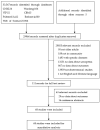Associated Factors of Sarcopenia in Community-Dwelling Older Adults: A Systematic Review and Meta-Analysis
- PMID: 34959843
- PMCID: PMC8707132
- DOI: 10.3390/nu13124291
Associated Factors of Sarcopenia in Community-Dwelling Older Adults: A Systematic Review and Meta-Analysis
Abstract
(1) Background: To review the associated factors of sarcopenia in community-dwelling older adults. (2) Methods: PubMed, Embase, Web of Science, and four Chinese electronic databases were searched for observational studies that reported the associated factors of sarcopenia from inception to August 2021. Two researchers independently selected the literature, evaluated their quality, and extracted relevant data. The pooled odds ratio (OR) and its 95% confidence interval (CI) were calculated for each associated factors of sarcopenia using random-effects/fixed-effects models. Publication bias was assessed using funnel plot and the Eggers test. We performed statistical analysis using Stata 15.0 software. (3) Results: A total of 68 studies comprising 98,502 cases were included. Sociodemographic associated factors of sarcopenia among community-dwelling older adults included age (OR = 1.12, 95% CI: 1.10-1.13), marital status (singled, divorced, or widowed) (OR = 1.57, 95% CI: 1.08-2.28), disability for activities of daily living (ADL) (OR = 1.49, 95% CI: 1.15-1.92), and underweight (OR = 3.78, 95% CI: 2.55-5.60). Behavioral associated factors included smoking (OR = 1.20, 95% CI: 1.10-1.21), physical inactivity (OR = 1.73, 95% CI: 1.48-2.01), malnutrition/malnutrition risk (OR = 2.99, 95% CI: 2.40-3.72), long (OR = 2.30, 95% CI: 1.37-3.86) and short (OR = 3.32, 95% CI: 1.86-5.93) sleeping time, and living alone (OR = 1.55, 95% CI: 1.00-2.40). Disease-related associated factors included diabetes (OR = 1.40, 95% CI: 1.18-1.66), cognitive impairment (OR = 1.62, 95% CI: 1.05-2.51), heart diseases (OR = 1.14, 95% CI: 1.00-1.30), respiratory diseases (OR = 1.22, 95% CI: 1.09-1.36), osteopenia/osteoporosis (OR = 2.73, 95% CI: 1.63-4.57), osteoarthritis (OR = 1.33, 95% CI: 1.23-1.44), depression (OR = 1.46, 95% CI: 1.17-1.83), falls (OR = 1.28, 95% CI: 1.14-1.44), anorexia (OR = 1.50, 95% CI: 1.14-1.96), and anemia (OR = 1.39, 95% CI: 1.06-1.82). However, it remained unknown whether gender (female: OR = 1.10, 95% CI: 0.80-1.51; male: OR = 1.50, 95% CI: 0.96-2.34), overweight/obesity (OR = 0.27, 95% CI: 0.17-0.44), drinking (OR = 0.92, 95% CI: 0.84-1.01), hypertension (OR = 0.98, 95% CI: 0.84-1.14), hyperlipidemia (OR = 1.14, 95% CI: 0.89-1.47), stroke (OR = 1.70, 95% CI: 0.69-4.17), cancer (OR = 0.88, 95% CI: 0.85-0.92), pain (OR = 1.08, 95% CI: 0.98-1.20), liver disease (OR = 0.88, 95% CI: 0.85-0.91), and kidney disease (OR = 2.52, 95% CI: 0.19-33.30) were associated with sarcopenia. (4) Conclusions: There are many sociodemographic, behavioral, and disease-related associated factors of sarcopenia in community-dwelling older adults. Our view provides evidence for the early identification of high-risk individuals and the development of relevant interventions to prevent sarcopenia in community-dwelling older adults.
Keywords: associated factors; community; meta-analysis; older adults; sarcopenia; systematic review.
Conflict of interest statement
The authors declare no conflict of interest.
Figures
References
-
- United Nations Department of Economic and Social Affairs (DESA)/Population Division World Population Prospects 2019. [(accessed on 26 January 2019)]. Available online: https://population.un.org/wpp/Download/Standard/Population/
-
- Cruz-Jentoft A.J., Baeyens J.P., Bauer J.M., Boirie Y., Cederholm T., Landi F., Martin F.C., Michel J.-P., Rolland Y., Schneider S., et al. Sarcopenia: European consensus on definition and diagnosis: Report of the European Working Group on Sarcopenia in Older People. Age Ageing. 2010;39:412–423. doi: 10.1093/ageing/afq034. - DOI - PMC - PubMed
-
- Fielding R.A., Vellas B., Evans W.J., Bhasin S., Morley J.E., Newman A.B., van Kan G.A., Andrieu S., Bauer J., Breuille D., et al. Sarcopenia: An Undiagnosed Condition in Older Adults. Current Consensus Definition: Prevalence, Etiology, and Consequences. International Working Group on Sarcopenia. J. Am. Med Dir. Assoc. 2011;12:249–256. doi: 10.1016/j.jamda.2011.01.003. - DOI - PMC - PubMed
Publication types
MeSH terms
Grants and funding
LinkOut - more resources
Full Text Sources




